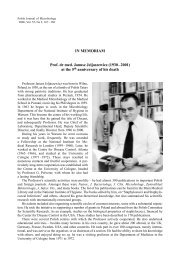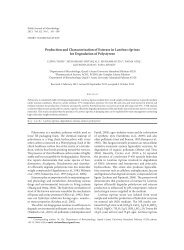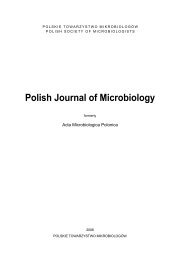No 3 - Polish Journal of Microbiology
No 3 - Polish Journal of Microbiology
No 3 - Polish Journal of Microbiology
Create successful ePaper yourself
Turn your PDF publications into a flip-book with our unique Google optimized e-Paper software.
3 Chitin-glucan production by S. commune<br />
227<br />
Fig. 7. Change <strong>of</strong> medium pH, pO 2 (%) and sucrose content in medium (g/l) during<br />
S. commune cultivation.<br />
aeration increase up to 2 vvm increased CGC content<br />
to 16.3 ± 0.3% only. Mycelium yield increased more<br />
than 2 times with increase <strong>of</strong> aeration from 0.5 vvm to<br />
2 vvm and reached the maximum value <strong>of</strong> 13.7 ± 0.6 g/l<br />
(Fig. 4). From the data above, there was calculated<br />
maximal CGC production <strong>of</strong> 2.2 ± 0.2 g/l under 2 vvm<br />
aeration.<br />
When the amount <strong>of</strong> schizophyllan was related to<br />
mycelium yield, it was found that the most intensive<br />
exopolysaccharide synthesis takes place at aeration <strong>of</strong><br />
1 vvm (Fig. 5). These indicate that aeration intensity<br />
can be used as the key regulator for redirection <strong>of</strong><br />
S. commune metabolism from schizophyllan synthesis<br />
to CGC accumulation.<br />
Cultivation conditions that favored high CGC production<br />
(YE 4 g/l, pH 6.5, aeration 2 vvm) were combined<br />
and effect <strong>of</strong> cultivation time on CGC and schizophyllan<br />
accumulation was studied in fermenter with<br />
50 l working volume. The culture reached stationary<br />
growth phase in 96 hours, the highest mycelium yield<br />
<strong>of</strong> 15.9 ± 0.9 g/l was recorded at that cultivation time as<br />
well (Fig. 6). Amount <strong>of</strong> CGC in mycelium increased<br />
during all cultivation and reached maximum value <strong>of</strong><br />
28.1 ± 0.2% in 168 hours. The highest CGC production<br />
<strong>of</strong> 3.5 ± 0.3 g/l was recorded in 144 hours <strong>of</strong> cultivation.<br />
The amount <strong>of</strong> schizophyllan in medium increased<br />
until 144 h <strong>of</strong> cultivation when it reached 2.4 ± 0.6 g/l,<br />
whereupon it started to decrease (Fig. 6).<br />
S. commune acidified medium to pH 4.9 in first<br />
72 hours, however then medium pH started to increase<br />
and reached 6.3 at the end <strong>of</strong> cultivation (Fig. 7). All<br />
sucrose was consumed within the first 96 hours. pO 2<br />
probe indicated 0% medium oxygen saturation beginning<br />
from 48 hours <strong>of</strong> cultivation (Fig. 7).<br />
By means <strong>of</strong> cultivation conditions optimisation<br />
CGC production by S. commune was increased more<br />
than 3.8 times. CGC content in mycelium was little<br />
sensitive to medium composition, but was increased<br />
by aeration intensification and cultivation time prolongation.<br />
Mycelium yield was increased by adjustment<br />
<strong>of</strong> YE content in the medium, medium initial pH and<br />
aeration intensity. Redirection <strong>of</strong> fungal metabolism<br />
from schizophyllan synthesis to CGC accumulation<br />
was achieved most efficiently by aeration intensity<br />
increase. The study showed the potential <strong>of</strong> S. commune<br />
submerged cultivation for industrial-scale CGC<br />
production. CGC from S. commune can find application<br />
in medicine and chitin/chitosan production as an<br />
alternative to CGC from Micromycetes.<br />
Acknowledgement<br />
We thank pr<strong>of</strong>. Ing. Radim Hrdina (Institute <strong>of</strong> Organic Chemistry<br />
and Technology, University <strong>of</strong> Pardubice, Czech Republic) for<br />
elementary analyses. This work was supported by a grant from EU<br />
funds and national budget <strong>of</strong> the Czech Republic under project<br />
Nr. FR-TI 1/151 “New Wound Dressings Based On Micro- and<br />
Nano- Carriers” covered by TIP platform.<br />
Literature<br />
Aguilar-Uscanga B. and J.M. Francois. 2003. A study <strong>of</strong> the yeast<br />
cell wall composition and structure in response to growth conditions<br />
and mode <strong>of</strong> cultivation. Lett. Appl. Microbiol. 37: 268–274.<br />
Amorim R.V.S., W. de Souza, K. Fukushima and G.M. Campos-<br />
Takaki. 2001. Faster chitosan production by Mucoralean strains in<br />
submerged culture. Braz. J. Microbiol. 32: 20–23.<br />
Arcidiacono S. and D.L. Kaplan. 1992. Molecular weight distribution<br />
<strong>of</strong> chitosan isolated from Mucor rouxii under different culture<br />
and processing conditions. Biotechnol. Bioeng. 39: 281–286.<br />
Berecochea-Lopez A., K. Decordé, E. Ventura, M. Godard,<br />
A. Bornet, P.L. Teissèdre, J.P. Cristol and J.M. Rouane. 2009. Fungal<br />
chitin-glucan from Aspergillus niger efficiently reduces aortic<br />
fatty streak accumulation in the high-fat fed hamster, an animal<br />
model <strong>of</strong> nutritionally induced atherosclerosis. J. Agric. Food Chem.<br />
57: 1093–1098.<br />
Ivshin V.P., S.D. Artamonova, T.N. Ivshina and F.F. Sharnina.<br />
2007. Methods for isolation <strong>of</strong> chitin-glucan complexes from higher<br />
fungi native biomass. Polym. Sci. 49: 305–310.<br />
Khan T.A., K.K. Peh and H.S. Ch’ng. 2002. Reporting degree <strong>of</strong><br />
deacetylation values <strong>of</strong> chitosan: the influence <strong>of</strong> analytical methods.<br />
J. Pharm. Pharmaceut. Sci. 5: 205–212.<br />
Machova E., G. Kogan, D. Chorvatovicova and J. Sandula. 1999.<br />
Ultrasonic depolymerization <strong>of</strong> the chitin-glucan complex from<br />
Aspergillus niger and antimutagenic activity <strong>of</strong> its product. Ultrason.<br />
Sonochem. 6: 111–114.






